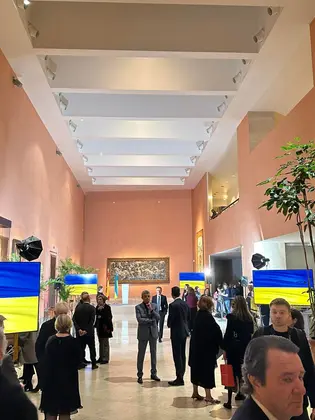Dozens of modern artworks removed from Kyiv to protect them from Russian strikes that have already done huge damage to Ukraine’s cultural heritage will go on display at a Madrid museum on Tuesday.
The works on show at the Thyssen-Bornemisza National Museum of Art as part of the “In the Eye of the Storm: Modernism in Ukraine 1900-1930” exhibition include oil paintings, sketches and collages.
Francesca Thyssen-Bornemisza founded “Museums for Ukraine” which is seeking to showcase Ukrainian art, using the museum which houses her late father’s collection for the exhibition.
The Madrid exhibition is one of a number of showings of Ukraine’s cultural heritage across Europe, as well as an effort to raise awareness of the threat posed to the war-torn country’s artistic legacy as fighting grinds on.
Curators say it is one of the most comprehensive surveys of Ukrainian modern art in the period between 1900 to 1930.
Many of the works have hardly been seen outside of Ukraine. The exhibition will run at the museum until April 30, and then go on show in Cologne in Germany from September 2023.
– ‘Vision’ of Russia’s destruction –
President Volodymyr Zelensky said in a video shown at a preview Monday that “this is a vision of what Russia is trying to destroy”.
After weeks of intense preparation, the pieces were loaded into two trucks in mid-November just before the Ukrainian capital came under intense missile fire.
As it headed to the Polish border the convoy avoided passing infrastructure likely to be attacked, Thyssen-Bornemisza said.
When the convoy reached the border, they found it shut because a missile had just landed in a Polish village killing two people.
Thyssen-Bornemisza said she then asked Ukraine’s ambassador to Spain for help, who in turn contacted “every politician he knew between Poland and Ukraine”.
“It took them 12 hours that night — they managed to get through,” she said.
UNESCO, the United Nations’ cultural agency, says over 200 cultural sites in Ukraine, including museums, have been damaged since Russia invaded Ukraine in February.
Krista Pikkat, UNESCO’s cultural and emergencies director, said in October that “cultural heritage is very often collateral damage during wars — but sometimes it’s specifically targeted”.
– ‘Talk about the war’ –
The exhibition follows a chronological order.
It starts with the 1910s when Ukraine was part of the Russian empire and ends in the 1930s when several artists died during purges carried out by Soviet dictator Joseph Stalin, said one of the show’s curators Katia Denysova.
Most of the works come from the National Art Museum of Ukraine.
Among the works on display is “Composition”, a Cubist-inspired painting by Vadym Meller and a realistic portrait of a soldier by Kostiantyn Yeleva.
“It is important for us to continue to talk about the war,” Denysova said.
“But we also want to show with this project that Ukraine has so much more to offer.”
You can also highlight the text and press Ctrl + Enter



